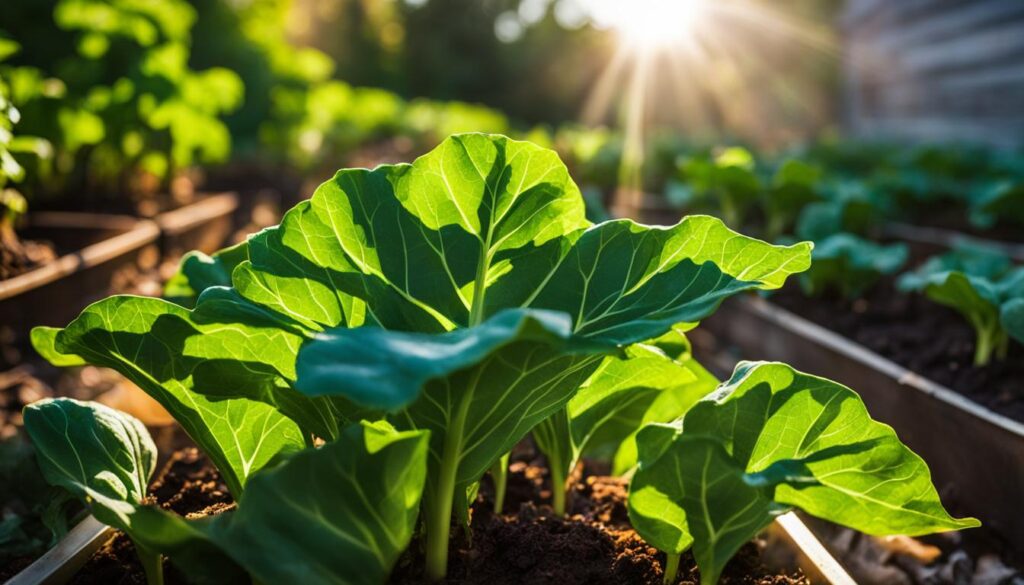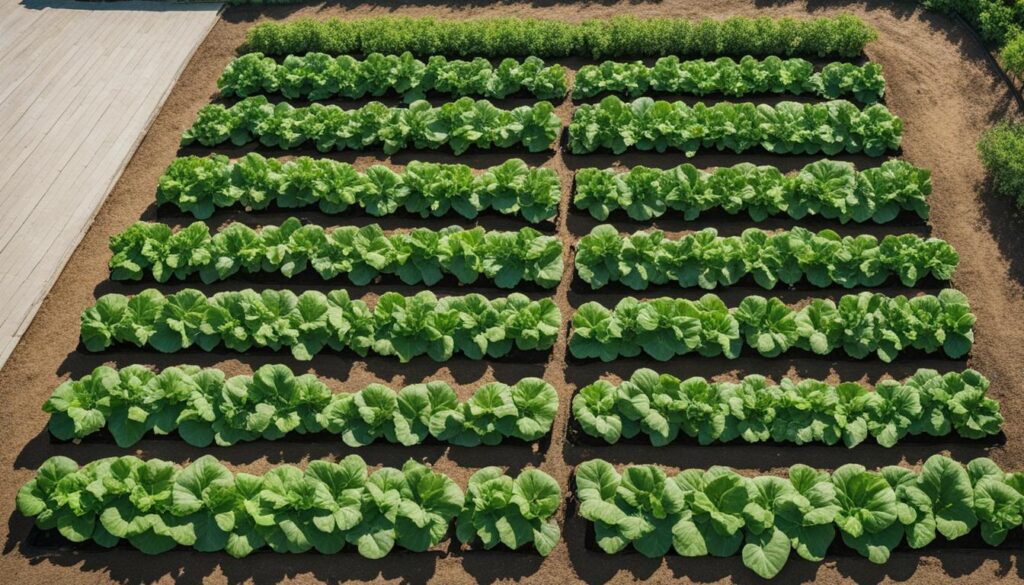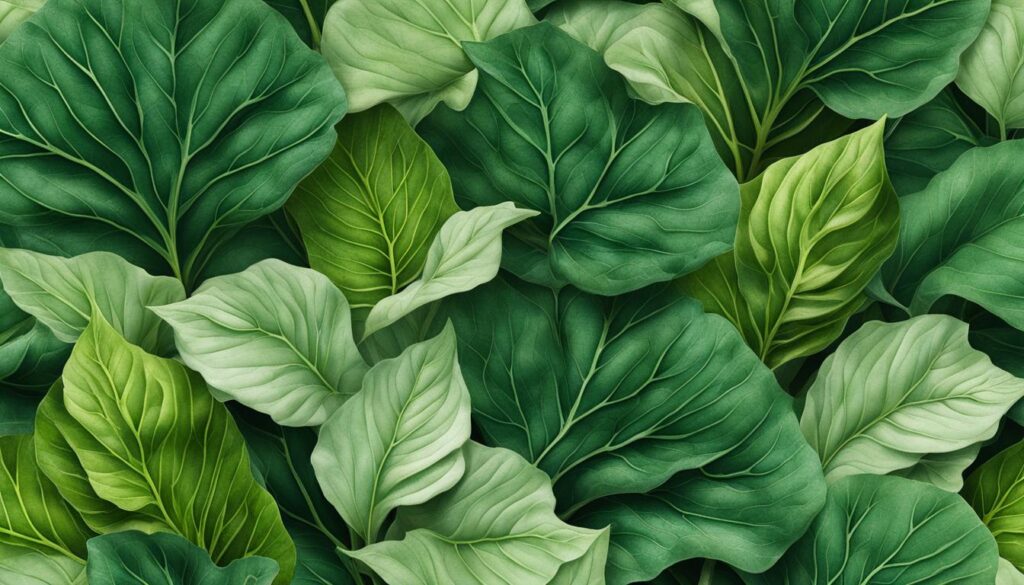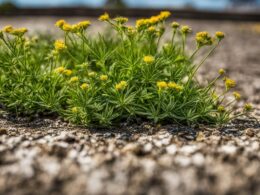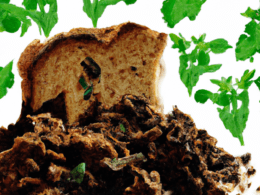Maximizing garden productivity requires smart planning and efficient use of space, especially when it comes to growing collards. By following a proper plant spacing guide and understanding the specific requirements of collard green spacing, you can optimize your garden space and enjoy a bountiful harvest of these nutrient-rich leafy vegetables.
Key Takeaways
- Optimal collard green spacing depends on the intended harvest size and planting method.
- Plant half-grown collards 10 to 15 inches apart and full-grown collards 15 to 18 inches apart.
- For young plants harvested like mustard greens, leave only 2 to 4 inches of space between them.
- Traditional single-row plantings need 36 to 42 inches apart, and multi-row bed systems have rows 12 to 18 inches apart.
- Proper plant spacing helps ensure healthy growth and maximizes garden productivity.
Understanding the Basics of Collard Greens
Collard greens, an essential part of the leafy vegetables family, distinguish themselves through the formation of a loose bouquet rather than a tight head like cabbages. These nutritious garden vegetables have gained popularity throughout the United States and find their place in numerous dishes, owing to their versatility.
As a cool-season crop, collard greens exhibit resilience against frosts and light to medium freezes. This characteristic renders them suitable for early spring or fall planting, allowing gardeners to enjoy their fresh, vibrant leaves throughout these seasons. Let’s delve into the key aspects of collard greens to give you an in-depth understanding of these leafy greens.
Origin and Nutritional Profile
Collard greens are a member of the Brassica oleracea family, sharing their origins with other cruciferous vegetables such as kale, broccoli, cauliflower, and Brussels sprouts. Native to the eastern Mediterranean and Asia Minor regions, these greens have both a rich history and abundant nutritional benefits.
- High in vitamins A, C, and K
- Richest source of calcium among all leafy greens
- Good source of dietary fiber
- Contain significant amounts of manganese, magnesium, and potassium
- Powerful antioxidants and anti-inflammatory nutrients
Growth Requirements
When it comes to collard greens basics, understanding their growth requirements is essential. These robust and versatile greens have the following preferences:
- Temperature: Best grown in cool temperatures, collard greens can tolerate light to medium freezes, thus performing well in early spring or fall.
- Soil: Collard greens thrive in fertile, well-drained soils with pH levels between 6.0 and 6.5.
- Water: Consistent moisture is vital, requiring approximately 1 to 1.5 inches of water per week.
- Sunlight: While they can tolerate some shade, they ideally need 4 to 5 hours of sun per day.
Popular Collard Green Cultivars
Over time, numerous collard green cultivars have been developed to cater to various preferences and needs. Some of the popular choices include:
| Cultivar | Features |
|---|---|
| Vates | Slow growing, large and tender leaves |
| Carolina Improved Heading | Produces a semi-compact head, large and flavorful leaves |
| Champion | Hybrid variety with an upright growth habit and dark green leaves |
| Georgia Southern | Uniform growth, high in essential nutrients |
| Morris Heading | Heirloom variety, medium-sized firm head |
With a comprehensive understanding of the collard greens basics, you are now well-equipped to explore various planting techniques, ideal planting seasons, and other critical aspects to grow these leafy delights successfully in your garden.
Choosing the Ideal Time and Location for Planting Collards
Collard greens thrive when planted in the early spring or fall, depending on regional climate conditions. The choice between spring planting and fall planting for collards primarily depends on the weather and geographic location of your garden. In colder regions, plantings are timed for midsummer or early spring, while in warmer areas like the Southern United States, collards can be grown almost year-round.
Spring Planting Versus Fall Planting
Understanding the planting seasons for collards plays a crucial role in their proper growth and development. Spring planting typically takes place in early spring, allowing collards to mature throughout the growing season and harvest before the summer heat. With fall planting, your collards are sown during late summer or early fall, providing a delightful fall harvest or even an overwintered crop in milder climates.
| Planting Season | Regions | Timing |
|---|---|---|
| Spring Planting | Colder Regions | Midsummer or Early Spring |
| Fall Planting | Warmer Regions | Late Summer or Early Fall |
| Year-Round Planting | Southern United States | Nearly All Year, With Proper Care |
Assessing Sunlight and Space Requirements
When preparing your garden for collard greens, ensure that the plants receive the appropriate amount of sunlight and that you accommodate for their space requirements. Collard greens need a balance of sunlight and shade, amounting to approximately 4 to 5 hours of sun per day. Location selection should take into account this need for both sunlight and shade as you find the perfect spot for your collard greens to grow.
In addition to sunlight, space consideration is crucial for your plants to thrive. Rows should be spaced 36 to 42 inches apart in conventional systems and 12 to 18 inches apart in multi-row beds. This spacing ensures sufficient room for collard greens to develop without overcrowding, leading to healthier plants and increased yields.
- Select the planting season based on your region’s climate.
- Ensure your garden spot provides enough sunlight for collard greens, approximately 4 to 5 hours per day.
- Plan space requirements for planting collards, with rows 36 to 42 inches apart for single rows, and 12 to 18 inches for multi-row beds.
Mastering Collard Green Planting Techniques
One of the essential factors in growing collard greens successfully is employing the right planting techniques. Utilizing precision seeding can greatly enhance the overall results by reducing seed use and providing uniform stands. In this section, we will explore the correct seed planting depth, moisture, and irrigation to maximize seed germination and stand quality.
To optimize collard green planting, seeds should be planted at a depth of ½ to ¾ inches, making sure not to exceed 1 inch. The soil should be moist, not too wet or too dry, providing the perfect environment for the seeds to germinate.
Irrigation is another key aspect that plays a significant role in seed germination. Maintaining proper moisture, especially during hot weather, is crucial to achieve healthy growth and prevent wilting. Below is a table outlining the recommended considerations for seed planting depth, moisture, and irrigation:
| Aspect | Recommendation |
|---|---|
| Seed Planting Depth | ½ to ¾ inches (do not exceed 1 inch) |
| Soil Moisture | Moist, but not overly wet or dry |
| Irrigation | Proper and consistent, especially during hot weather |
Precision seeders are highly recommended for collard green planting, as they can efficiently control seed distribution, leading to a more uniform stand. Additionally, precision seeders use fewer seeds compared to traditional seeding methods, yielding cost-effective results.
- Choose a high-quality precision seeder for consistent seeding distribution.
- Plant seeds at the recommended depth of ½ to ¾ inches.
- Maintain proper soil moisture for optimal germination.
- Follow recommended irrigation practices, especially during hot weather.
By mastering collard green planting techniques, specifically precision seeding, seed germination, and stand quality, you can ensure a healthy, thriving crop that will ultimately produce a bountiful harvest.
Spacing Recommendations for Maximized Yields
Optimizing your harvest size, collard greens yield, row spacing, plant spacing, and gardening systems are crucial factors in achieving a bountiful crop. The following information will help you determine the most effective spacing for collard greens in both traditional gardening and multi-row systems.
Determining Plant Spacing Based on Harvest Size
The ideal plant spacing for collard greens depends on the intended harvest size. Below is a guide to help you gauge the correct plant spacing:
- For half-grown plants, space plants 10 to 15 inches apart.
- For fully grown plants, space plants 15 to 18 inches apart.
- For harvesting young plants, a closer spacing of 2 to 4 inches is adequate.
Row Spacing for Traditional and Multi-Row Systems
Row spacing is another significant aspect of maximizing yield and quality. Here’s a breakdown of row spacing for traditional and multi-row systems:
| Gardening System | Row Spacing | Description |
|---|---|---|
| Traditional Single-Row System | 36 to 42 inches apart | Typically used in home gardens and smaller plots. |
| Multi-Row Bed System | 12 to 18 inches apart on beds 38 to 60 inches apart | Yields higher collard green crop due to rapid ground cover and reduced weed competition. Suited for larger gardens and commercial farms. |
By considering your desired harvest size and choosing the appropriate row spacing for your gardening system, you can optimize collard greens yield and get the most out of your garden.
Soil Preparation for Collard Green Success
Proper soil preparation plays a vital role in the growth and yield of collard greens. The ideal soil for collards is rich in organic matter, well-drained, and has a suitable soil pH range of 6.0 to 6.5. Understanding the differences between soil types and their impact on collard growth can significantly improve your garden’s productivity.
There are two main types of soils often recommended for growing collards:
- Heavy loamy soils: These soils produce the best yields as they’re naturally high in organic matter and nutrient-rich.
- Light sandy soils: Ideal for early spring crops, these soils warm up quickly and promote faster germination and plant growth.
To ensure your soil meets the necessary requirements for collard greens, follow these crucial steps:
Conduct a Soil Test
A soil test provides essential information about your garden’s nutrient levels and pH levels. Based on the results, you can make the necessary amendments to create the ideal environment for collard growth. Soil testing kits are readily available online or at local garden centers.
Amend the Soil
Depending on the soil test results, incorporate organic matter such as compost, aged manure, or leaf mold to improve soil fertility and drainage. Organic matter helps retain moisture and provides vital nutrients for collard greens.
Use the table below as a guide to soil amendments:
| Soil Test Result | Amendment |
|---|---|
| Low pH (below 6.0) | Lime |
| High pH (above 6.5) | Sulfur |
| Low in organic matter | Compost, aged manure, leaf mold |
| Poor drainage | Perlite, sand, raised beds |
Remember, soil preparation is a crucial aspect of successful collard green growth. By following these guidelines and incorporating the necessary amendments, you can create a fertile and well-drained soil environment conducive to thriving collard greens.
Selecting the Right Collard Varieties for Your Garden
Choosing the right collard varieties can make a significant difference in the success and health of your collard greens. This involves considering factors such as environmental conditions, space constraints, and personal preferences. To help guide your decision-making process, we’ve put together a list of popular heirloom collards and hybrid collards that consistently perform well in a wide range of gardens.
- Vates: This variety has dark green, smooth-edged leaves and is known for its excellent cold tolerance and rapid growth rate.
- Carolina Improved Heading: Featuring smooth, dark-green leaves, this collard green matures rapidly and offers outstanding heat and cold tolerance.
- Georgia Southern: With slow-bolting characteristics and thick, tender leaves, Georgia Southern is an excellent choice for warm weather areas or gardeners who prefer a more extended growing season.
- Blue Max: This hybrid variety stands out for its deep green, smooth leaves, which are suitable for fresh consumption or cooking.
- Heavi Crop: As its name suggests, Heavi Crop is known for providing large, dense, tender leaves and an impressive yield.
In addition to these popular picks, consider trying some lesser-known heirloom or hybrid varieties that cater to your specific needs. For example, Tiger and Champion are hybrid cultivars that have gained quite a following for their disease resistance and exceptional growth. On the other hand, the heirloom Morris Heading is revered for its mild flavor and resistance to bolting in hotter climates.
Ultimately, the collard variety you choose should match your garden’s conditions, fulfill your personal preferences, and provide a bountiful harvest. By understanding the unique attributes of various collard varieties, you will be better equipped to select the most suitable ones for your own garden and enjoy flavorful, nutritious greens season after season.
Expert Tips for Watering and Fertilizing Collards
For a thriving and healthy collard greens garden, it’s essential to strike a balance between collard green watering and fertilizing collards. Both aspects are crucial for high-quality leaf production in your crop. This section will discuss proper watering techniques, soil moisture maintenance, and useful fertilizing strategies to ensure the successful growth of your collards.
Water is vital for collard greens’ overall health and growth. The optimal figure is 1 to 1.5 inches of water per week for an even moisture supply. Insufficient watering may lead to slow growth and tough leaves, while excessive watering can cause waterlogged soil and promote diseases. So, keeping a balanced soil moisture is crucial for a successful harvest.
- Monitor Soil Moisture: Regularly check the soil around your plants, ensuring it’s moist and not oversaturated. Adjust your watering schedule accordingly.
- Water in the Morning: Watering early in the day minimizes water loss through evaporation and allows plants to absorb moisture before daylight’s heat can stress them.
- Deep Watering: Providing water at the root level ensures it reaches the plant’s root zone, encouraging deeper root growth for better overall health.
In addition to proper watering techniques, fertilizing collards is equally essential in ensuring lush, nutritious, and high-yielding plants. Pay particular attention to nitrogen, as it is crucial for leaf growth. One common method is to apply calcium nitrate at specific intervals after planting, which promotes strong growth and healthy collard greens.
| Time after Planting | Fertilizer Application |
|---|---|
| 7-10 days | Apply 33% of the total recommended nitrogen. |
| 4 weeks | Apply an additional 33% of the total recommended nitrogen. |
| 8 weeks | Apply the final 33% of the total recommended nitrogen. |
By following these expert tips for collard green watering and fertilizing collards, along with paying close attention to soil moisture levels, you can optimize the health and growth of your collard greens, ultimately resulting in a bountiful harvest.
Should I Plant Swiss Chard and Collards Together in My Garden for Companion Planting?
Yes, you can definitely plant Swiss chard and collards together in your garden for companion planting. These two crops complement each other well and can help deter pests and improve soil health. Collards are known as excellent companion plants for Swiss chard, creating a thriving and healthy garden.
Conclusion
Collard greens gardening can be a rewarding experience when following the guidelines discussed in this article. By paying attention to plant care, such as choosing the right collard variety and proper planting techniques, you are likely to enjoy an optimal collard harvest.
Remember that spacing is crucial for collard greens’ success, with different spacing requirements based on your preferred harvest size and chosen garden bed system. Proper soil preparation, including testing and amendments, will ensure your collards have a fertile and well-drained environment, while adhering to proper watering and fertilization practices will promote healthy growth.
With steadfast commitment and proper plant management, you can optimize your garden space and yield a bountiful collard harvest. Implementing these strategies, your collard greens will not only thrive but also provide you with ample nutrient-rich leafy vegetables to enjoy.






